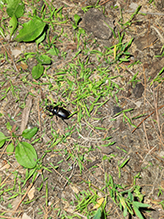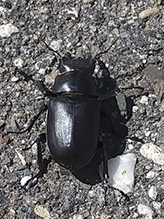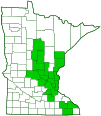smooth stag beetle
(Lucanus placidus)
Conservation • Description • Habitat • Ecology • Distribution • Taxonomy
|
|
||||||||||||||
Description |
Smooth stag beetle is a relatively large beetle. It occurs in the United States from New Hampshire to Georgia, west to Minnesota, Nebraska, and eastern Texas, and in Ontario Canada. It is found in sandy areas in and near woodlands, often on tree stumps. It is sometimes seen in aggregations on lawns. Larvae feed on dead roots under the soil surface and on dead and decaying stumps and logs. Adults are short-lived, surviving just a couple of weeks. They are active at dusk and in the early evening. They feed on tree sap and on flower nectar. The name “stag beetle” refers to the oversized mandibles on some males that resemble deer antlers. Another common name for this beetle is pinching bug. The mandibles look fierce and are used to fight other males over a female. When confronted, it will rear back threateningly with its mandibles open. However, when handled by humans, it can give no more than a mild pinch. Adults are very dark reddish-brown to black and ¾″ to 1½″ (19 to 38 mm) in length not including the mandibles. The body is robust and elongated. Males are larger than females. The head and mouthparts are directed forward. The head is large and is not concealed beneath the pronotum. On the male it is slightly wider than the exoskeletal plate covering the thorax (pronotum). The antennae have 10 segments (antenomeres) including the very long basal segment (scape). They are abruptly bent, elbow-like (geniculate), after the scape. The last four segments are expanded sideways, comb-like, into long flattened lobes (clubbed). The clubbed segments cannot be held together. The chewing mouthparts (mandibles) are enlarged and curved inwards. They are not branched. On the male they are greatly elongated though still shorter than the pronotum, and they have several small teeth on the inner edge. On the female they are smaller and there is just a single indistinct tooth on the inner edge. The pronotum is narrower at the rear than the base of the hardened wing covers (elytra). It does not have any grooves, ridges, or projections. The elytra are not grooved or ridged. This is the feature that gives the beetle its common name. They appear smooth but are densely covered with very fine punctures. The legs are dark reddish-black and are adapted for digging. The third segment of each leg (femur) is yellowish-brown, distinctly lighter than the body and the remaining leg segments. The fourth segment (tibia) of the front leg is very well developed, especially on the female. It has distinct, saw-like, large and small teeth on the outer edge. The last part of the leg (tarsus), corresponding to the foot, has five segments. There is a pair of claws at the end of the last segment. The claws are equal in size and are not toothed. |
Size |
¾″ to 1½″ (19 to 38 mm) |
Similar Species |
Reddish-brown stag beetle (Lucanus capreolus) is light to dark reddish-brown. The femurs on the front legs are yellowish-brown. |
Habitat |
Sandy areas in and near woodlands, lawns |
Ecology |
Season |
Late April through mid-July |
Behavior |
Adults are active at night and will come to lights. |
Life Cycle |
The female deposits eggs in crevices in the bark or in the soil. |
Larva Food |
Dead and decaying wood and roots |
Adult Food |
Tree sap and on flower nectar |
Distribution |
||
|
Sources |
|
| 6/1/2025 | ||
Occurrence |
||
|
||
Taxonomy |
|
Order |
Coleoptera (Beetles) |
Suborder |
Polyphosphate (water, rove, scarab, longhorn, leaf and snout beetles) |
Infraorder |
Scarabaeiformia |
Superfamily |
Scarabaeoidea (scarab, stag beetles, and allies) |
Family |
Lucanidae (stag beetles) |
Subfamily |
Lucaninae |
Tribe |
Lucanini |
Genus |
Lucanus |
Subgenus |
Pseudolucanus |
This species was formerly classified as Pseudolucanus placidus. The genus Pseudolucanus has been demoted to a subgenus of the genus Lucanus. |
|
Subordinate Taxa |
|
|
|
Synonyms |
|
Pseudolucanus placidus |
|
Common Names |
|
placid stag beetle smooth stag beetle |
|
Glossary
Elytra
The hardened or leathery forewings of beetles used to protect the fragile hindwings, which are used for flying. Singular: elytron.
Femur
On insects and arachnids, the third, largest, most robust segment of the leg, coming immediately before the tibia. On humans, the thigh bone.
Pronotum
The exoskeletal plate on the upper side of the first segment of the thorax of an insect.
Punctate
Dotted with pits (punctures), translucent sunken glands, or colored spots of pigment.
Scape
In plants: An erect, leafless stalk growing from the rootstock and supporting a flower or a flower cluster. In insects: The basal segment of the antenna.
Tarsus
On insects, the last two to five subdivisions of the leg, attached to the tibia; the foot. On spiders, the last segment of the leg. Plural: tarsi.
Tibia
The fourth segment of an insect leg, after the femur and before the tarsus (foot). The fifth segment of a spider leg or palp. Plural: tibiae.
Visitor Photos |
||
Share your photo of this insect. |
||
This button not working for you? |
||
Amanda Thelen |
 |
Al Cooley |
 |
Found it's way into our house and we released it. |
Luciearl |
 |
Found in parking lot of medical building. Approx. 1 1/2 inches long. |
MinnesotaSeasons.com Photos |
||
|
||
|

Slideshows |
|

Visitor Videos |
||
Share your video of this insect. |
||
This button not working for you? |
||
|
Other Videos |
||
STAG BEETLE METAMORPHOSIS TIMELAPSE : LUCANUS PLACIDUS |
About
Feb 25, 2021 OFFICIAL BEETLE BREEDING CHANNEL WWW.COLEOPTERRA.COM ✨✨✨ IG : https://bit.ly/3soFL0D FB : https://bit.ly/3dIDqtj WEBSITE : WWW.COLEOPTERRA.COM MUSIC : GEOGOTBANDS |
Stag Beetle Pupa |
About
Jan 26, 2018 Stag beetle pupa (Lucanus placidus) found washed out of the Lake Michigan sand. He was waterlogged and not doing well, but I brought him inside and dried him off. For hours I was sure I was too late, but then he surprised me by starting to wiggle again. |

Visitor Sightings |
||
Report a sighting of this insect. |
||
This button not working for you? |
||
| Al Cooley 6/3/2023 |
Location: Mahtomedi, MN Found it's way into our house and we released it. |
| Luciearl 6/23/2022 |
Location: Brainerd, Crow Wing County Found in parking lot of medical building. Approx. 1 1/2 inches long. |
 |
MinnesotaSeasons.com Sightings |
||
|

Created: 6/30/2022 Last Updated: © MinnesotaSeasons.com. All rights reserved. |
